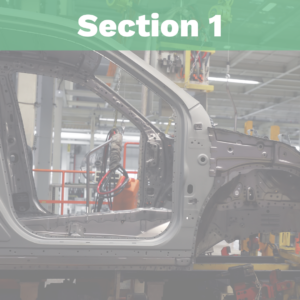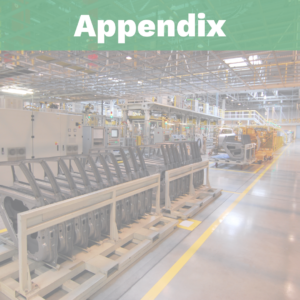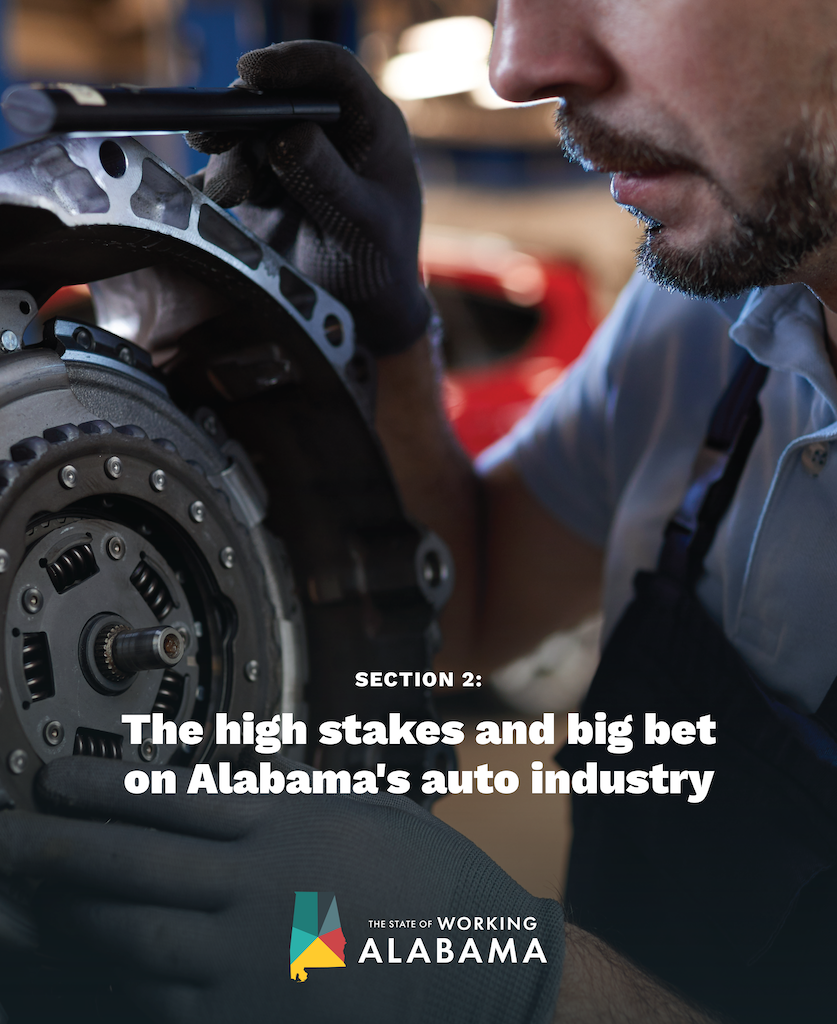Since the early 1990s, Alabama has bet big on the auto industry, and the stakes have always been high. At the time the state succeeded in recruiting Mercedes in 1993, Alabama’s economy was headed in the wrong direction. Alabama was lagging because policymakers failed to modernize state laws by shifting away from centuries of persistently anti-worker policies. State residents faced poverty rates higher than the national average, median household incomes below the national average, and significant gaps in economic outcomes between white and Black residents.[9]
Unfortunately, Alabamians still face these problems today. Alabama has been one of the nation’s poorest states ever since the Civil War.[10] This is due in large part to the state’s history of racial discrimination and a long-term skepticism of using public power and tax revenues to support broadly shared prosperity.[11]
Alabama’s approach to economic development from the Civil War through to the 1980s practically guaranteed the persistence of poverty, economic distress and racial inequality. State leaders focused centrally on “desperate attempts to attract low-skill, low-wage industries … with tax exemptions coupled with government repression of unions that could have pushed for higher wages.”[12] To a large extent, these same flawed practices are still in use today. Researchers of Alabama’s economy have long found that this “low-road” approach contributes heavily to the state’s elevated poverty rate.[13] By the late 1980s, Alabama’s economic development model was noticeably failing, with steep declines in the state’s textile, coal, steel and paper industries due to globalization.[14]

The promise of Alabama’s auto industry
Alabama’s development officials viewed the auto industry as an important way to replace the thousands of jobs lost in these declining industries with new good-paying jobs.[15] In fact, Americans have long perceived manufacturing jobs as being “good jobs.” As recently as 2014, “[n]ine out of ten Americans believe[d] that a strong manufacturing base is very important to our country’s standard of living.”[16] For decades, “[p]oliticians, economists, and other promoters [have] tout[ed] increased investment by manufacturers” when emphasis on “the benefits of direct and ‘value added’ industry cluster jobs flowing from manufacturing plants, and the overall economic boost that manufacturing jobs bring to local economies.”[17]
When the news broke that Mercedes was coming to Alabama in the early 1990s, “[t]he Vance plant [wa]s expected to create more than 10,000 jobs, most of which w[ould] come from support industries supplying parts, transportation, construction materials and services.”[18] In addition, in 1993, supporters touted Mercedes as having the potential over the next decade (by 2003) to increase jobs in the state by 15,000 to 17,000.[19] And the expectation was that by 2013, Alabama would witness “the creation of 4,375 jobs in manufacturing by Mercedes-Benz and its suppliers.”[20]
Within the manufacturing industry, motor vehicle and supply manufacturing historically has been the largest manufacturing sector, making up a significant portion of the nation’s economy.[21] In addition, the average salary of auto industry workers historically has “far outpaced other private-sector jobs.”[22] For example, during the mid-20th century, “the industry-wide average wage was roughly 30 percent higher than the average for the private-sector as a whole. It then rose relative to the private-sector average in the 1970s, peaking in the mid-1980s at more than 150 percent of the average private-sector wage.”[23]
Thus, when the opportunity arose for Alabama to go above and beyond other states in an attempt to woo auto manufacturers to the state in the 1990s, it is no surprise that “[e]xpectations [we]re high on the part of the state, local governments, and communities about employment, income, and revenue generation” that would follow if auto manufacturers came to our state.[24] In fact, in 1993, when Mercedes announced its decision to build a facility in Alabama, “[t]he average annual wage in the industry for hourly production workers [wa]s about $34,000.”[25] Put in context, the average annual pay in the United States in 1993 was only $26,361, and it was only $22,786 in Alabama.[26]
In August 1994, as thousands of Alabama residents began competing to fill available jobs at the Mercedes plant, “[u]p for grabs [we]re 1,500 jobs paying an estimated $12 to $18 an hour,”[27] or the equivalent of $24,960 to $37,440 annually. That same year, the average annual pay nationwide was $26,939, and in Alabama, it was only $23,616.[28] It is thus safe to assume that the people of Alabama expected that Mercedes jobs would be good-paying jobs that would help lift tens of thousands of Alabamians into the middle class.
Alabama bets big on the auto industry
To achieve these development goals and address the state’s broader economic challenges, Alabama’s policymakers – from Gov. Jim Folsom Jr. in 1993 to Gov. Kay Ivey today – have bet big on the auto industry with expensive economic development incentive packages and major expenditures of public funds.[29] For example, the state’s final bid to win Mercedes in 1993 included an estimated $253 million for total initial buildout, which also included “$8.7 million in waived sales and use tax revenues, a $600,000 fire station, $11 million worth of water and sewer improvements, $90 million in training costs and $50 million worth of highway work.”[30] This came to $293,000 for each projected job,[31] the largest package in Alabama history. A worker earning the state household median income would take more than five years to earn that amount. In 2000, the state offered Mercedes another round of incentives, worth $119 million, to support a $600 million expansion of the Vance plant.[32]
Beyond Mercedes, the state has invested a considerable amount in recruiting and expanding auto plants over the past 20 years.[33] Hyundai incentives for initial buildout were $90,000 per job in 2021 dollars.[34] Toyota’s initial incentives were $121,000 per job, and incentives for the 2021 plant totaled $700 million.[35] [36] Honda’s initial incentives were $106,000 per job.[37]
As the major auto plants expanded, they received additional incentives. For example, in 2002, the Hyundai plant received $234.6 million in state and local incentives for the original plant location in Montgomery County.[38] And after the Montgomery plant was operational, the state granted an additional $59 million to Hyundai for a plant expansion.[39]
Over the years, the total incentive amounts for auto manufacturing plants have been well above $1.5 billion, as seen in Figure 2.1.

The stakes remain high
Providing such large incentives was a big bet, and 30 years later, the stakes for Alabama are still high. Despite the influx of auto manufacturing jobs that have come to our state, Alabama remains a poor state.[40] Based on 2019 U.S. Census data, Alabama is the seventh poorest state in the nation and contains five of the nation’s 100 poorest counties.[41] The Alabama median family income also has long remained below the national average.[42] In 2021, the national annual median household income was approximately $71,000,[43] but in Alabama, it was just under $55,000.[44] More than 16% of Alabamians lived below the federal poverty line that year,[45] compared to 12% of the population nationwide.[46] Similarly, Alabama lags behind most other states in terms of overall health outcomes,[47] education quality and attainment,[48] child well-being[49] and overall equality.[50]
Given the stakes, how is the big bet on the auto industry paying off? Who in Alabama is benefiting most from the industry’s growth and strength? Workers? Or corporations?
Additional sections
 Executive summary
Executive summary
 Introduction
Introduction
 The ways the bet on auto benefited Alabama
The ways the bet on auto benefited Alabama
 A wheel in the ditch: Autoworkers see falling pay
A wheel in the ditch: Autoworkers see falling pay
 A wheel in the ditch: Pay gaps and occupational segregation
A wheel in the ditch: Pay gaps and occupational segregation
 A wheel in the ditch: Economic impact of falling wages and the pay gap
A wheel in the ditch: Economic impact of falling wages and the pay gap
 A wheel in the ditch: Working conditions worsen
A wheel in the ditch: Working conditions worsen
 The auto industry and Alabama’s low-road economic development approach
The auto industry and Alabama’s low-road economic development approach
 What we should do next
What we should do next
 Research design and methodology
Research design and methodology
[9] U.S. Census Bureau, 2021 American Community Survey: Poverty Status in the Past 12 Months, Alabama and United States, https://data.census.gov/table?q=alabama+poverty&g=010XX00US&tid=ACSST1Y2021.S1701.
[10] Flynt, supra note 2.
[11] Ibid.
[12] Ibid.
[13] Ibid.
[14] Atkins, supra note 8.
[15] Ibid.
[16] Catherine Ruckelshaus & Sarah Leberstein, “Manufacturing Low Pay: Declining Wages in the Jobs that Built America’s Middle Class,” National Employment Law Project (Nov. 2014), https://s27147.pcdn.co/wp-content/uploads/2015/03/Manufacturing-Low-Pay-Declining-Wages-Jobs-Built-Middle-Class.pdf.
[17] Ibid.
[18] Lisa Rukeyser, “Potential suppliers scramble for work,” Montgomery Advertiser (Oct. 1, 1993), 15.
[19] Ibid.
[20] Ibid.
[21] Ruckelshaus & Leberstein, supra note 16.
[22] Ibid.
[23] Ibid.
[24] Ellene Kebede & Mudiayi Sylvain Ngandu, “The Economic Impact of the Mercedes Benz Investment on the State of Alabama,” Journal of Agricultural and Applied Economics (Aug. 1999), https://ageconsearch.umn.edu/record/15385.
[25] Rukeyser, supra note 18.
[26] U.S. Bureau of Labor Statistics, “Average Annual Pay By State and Industry, 1994,” https://www.bls.gov/news.release/history/annpay_091995.txt.
[27] David Rynecki, “Thousands vie for Mercedes jobs,” Birmingham Post-Herald (Aug. 16, 1994).
[28] U.S. Bureau of Labor Statistics, supra note 26.
[29] Peter Calcagno & Frank L. Hefner, “Economic Development Tax Incentives: A Review of the Perverse, Ineffective, and Unintended Consequences” (Jan. 3, 2018), https://ssrn.com/abstract=3173791. Excerpt from Adam J. Hoffer & Todd Nesbit, eds., For Your Own Good: Taxes, Paternalism, and Fiscal Discrimination in the Twenty-First Century (2018).
[30] Wayne Grayson, “Incentives package caused early controversy,” Tuscaloosa News (Sept. 21, 2003), https://www.tuscaloosanews.com/story/news/2003/09/21/incentives-package-caused-early-controversy/27848187007.
[31] Calcagno & Hefner, supra note 29.
[32] William Thornton, “As Alabama tries to lure Toyota-Mazda, suppliers will be key,” AL.com (Aug. 17, 2017), https://www.al.com/business/2017/08/as_alabama_tries_to_lure_toyot.html.
[33] Calcagno & Hefner, supra note 29.
[34] Ibid. at 233, citing University of South Carolina Division of Research, adjusted to 2021 dollars.
[35] Associated Press, “Alabama incentives for Toyota-Mazda factory top $700 million” (April 20, 2021), https://apnews.com/article/e55cef4b83314f38af801840d5106a54.
[36] Calcagno & Hefner, supra note 29.
[37] Wayne Grayson, “Honda deal is state’s cheapest incentive package ever,” Tuscaloosa News (July 11, 2002), https://www.tuscaloosanews.com/story/news/2002/07/11/honda-deal-is-states-cheapest-incentive-package-ever/27825333007.
[38] Dana Beyerle, “Incentive package entices Hyundai,” Tuscaloosa News (April 5, 2002), https://www.tuscaloosanews.com/story/news/2002/04/05/incentive-package-entices-hyundai/27820998007.
[39] William Thornton, “State offered $59 million incentive package to Hyundai,” AL.com (June 1, 2018), https://www.al.com/business/2018/06/state_offered_59_million_in_in.html.
[40] Emily Erickson, Are Good Jobs Possible in the Deep South?, Alabama A&M University (March 2021), https://www.aamu.edu/academics/colleges/agricultural-life-natural-sciences/departments/community-regional-planning/_documents/are-good-jobs-possible-in-the-deep-south-erickson-march-2021.pdf.
[41] Flynt, supra note 2.
[42] Encyclopædia Britannica, supra note 3.
[43] U.S. Census Bureau, supra note 4.
[44] U.S. Census Bureau, QuickFacts Alabama, https://www.census.gov/quickfacts/fact/table/AL/BZA210221.
[45] Statista, “Poverty Rate in Alabama,” https://www.statista.com/statistics/205388/poverty-rate-in-alabama.
[46] U.S. Census Bureau, “Poverty Awareness Month,” https://www.census.gov/newsroom/stories/poverty-awareness-month.html.
[47] UnitedHealthcare, “The greatest health strengths and challenges in Alabama” (Jan. 3, 2023), https://www.uhc.com/agents-brokers/employer-sponsored-plans/local-markets/alabama/alabama-health-rankings.
[48] World Population Review, “Least Educated States” (updated June 2023), https://worldpopulationreview.com/state-rankings/least-educated-states (stating “Alabama is the country’s fifth-least educated state. Alabama’s Education Attainment rank is 45, and its Quality of Education rank is 38.”).
[49] Equal Justice Initiative, “Alabama Ranks Among Nation’s Lowest in Child Well-Being, Life Expectancy” (April 14, 2022), https://eji.org/news/alabama-ranks-among-nations-lowest-in-child-well-being-life-expectancy.
[50] U.S. News & World Report, “Rankings: Equality – Best States,” https://www.usnews.com/news/best-states/rankings/opportunity/equality?region=AL.





